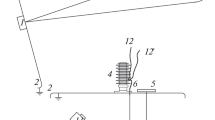Abstract
The results of physical simulations of the impact of atmospheric electricity and lightning on the elements of monitoring systems with hollow dielectric shells (caps) using an artificial-lightning cell with negative polarity have been presented. It has been established that, under the effect of artificial-lightning cells on the sensor under a dielectric cap, a positive streamer flash and quasi-permanent discharge processes are first formed, which turn into a powerful reverse discharge with opposite polarity. The influence of dielectric-cap volumes and the curvature radii of model sensors located under them on the parameters of discharge-current pulses has been found. It is shown that, with an increase in the internal volume of a dielectric cap, the current-pulse amplitude of a streamer corona and the transferred charge of a reverse discharge on the rod model electrode under the cap increase. It has been established that, with an increase in the radius of the rod electrode tip, the reverse discharge neutralizes a larger charge, and the current pulses amplitudes of a negative reverse discharge and the steepness of a current pulse exceed those for a positive streamer flash. It is shown that the parameters of signals (current pulses) generated on the elements of overhead power-line monitoring systems protected by dielectric shells under the influence of thunderclouds and lightning will be affected by the accumulation of charges on the inner and outer surfaces of the shell.



Similar content being viewed by others
REFERENCES
Temnikov, A.G., Using of artificial clouds of charged water aerosol for investigations of physics of lightning and lightning protection, IEEE Int. Conf. on Lightning Protection (ICLP), Vienna, 2012, IEEE, 2012, pp. 1–13. https://doi.org/10.1109/ICLP.2012.6344279
Temnikov, A.G., Chernensky, L.L., Orlov, A.V., Kivshar, T.K., Lysov, N.Y., Belova, O.S., and Zhuravkova, D.S., Peculiarities of the electric field calculation of the artificial thunderstorm cells, Int. J. Circuits, Syst. Signal Process., 2018, vol. 12, pp. 305–311.
Rakov, V.A. and Uman, M.A., Lightning: Physics and Effects, Boca Raton, Fla.: Cambridge Univ. Press, 2003.
Mazur, V.A., Principles of Lightning Physics, Bristol: IoP Publishing, 2016.
Funding
This study was carried out at National Research University “Moscow Power Engineering Institute” and supported by the Ministry of Science and Higher Education of the Russian Federation as part of a state assignment, project no. FSWF-2020-0019.
Author information
Authors and Affiliations
Corresponding author
Ethics declarations
The authors declare that they have no conflicts of interest.
Additional information
Translated by M. Astrov
About this article
Cite this article
Temnikov, A.G., Belova, O.S., Chernensky, L.L. et al. Application of an Artificial Thunderstorm Cell to Study the Effect of Atmospheric Electricity and Lightning on the Elements Protected by Dielectric Shells in Overhead Power-Line Monitoring Systems. Russ. Electr. Engin. 93, 220–223 (2022). https://doi.org/10.3103/S1068371222040101
Received:
Revised:
Accepted:
Published:
Issue Date:
DOI: https://doi.org/10.3103/S1068371222040101




